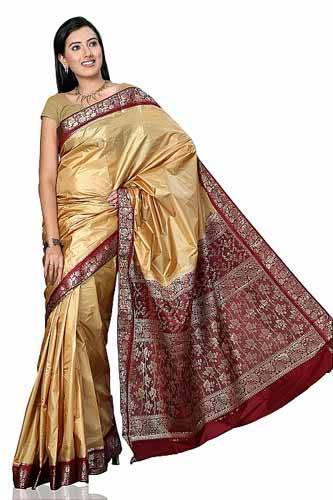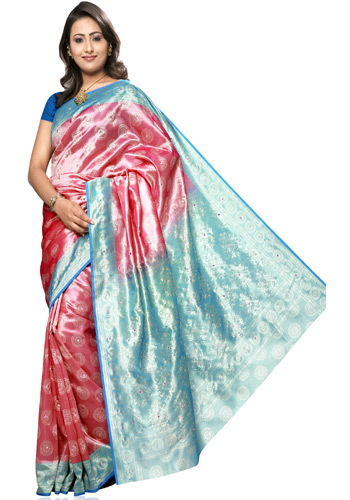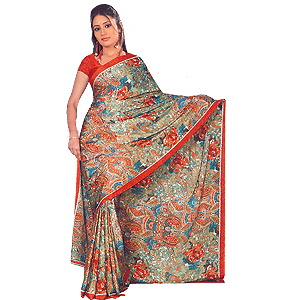Indian Silk Sarees Biography
Source (google.com.pk)










Source (google.com.pk)
The agriculture industry today employs over 700,000 farm families and is mostly concentrated in Karnataka, Tamilnadu and Andhra Pradesh and to some extent Assam and West Bengal. Karnataka accounts for more than 70 percent of the country's total silk production.
Sericulture is one industry which is beneficial to the agriculturists. As in today 56 lakhs people are dependent on the sericulture industry, 5.6 million people out of which 4.7 million are agriculturists. The rest are reelers, weavers etc.
India is the second largest producer of silk, contributing to about 18 per cent to the world production. What is however, more noteworthy is the fact that India's requirement of raw silk is much higher than its current production at present. Thus, there is considerable scope for stepping up production of raw silk in the country, overcome the persistent conflict of interest between exporters of silk products and producers of raw silk.While sericulturists want imports of raw silk to be restricted to have better market for their produce, exporters want imports of cheaper raw silk so as to be able to export more silk products at competitive rates. India has all the four varieties of silk namely, mulberry, tassar, eri and muga. It is however, disheartening to note that we have not yet been able to fully exploit this advantage and make our presence felt on the international scene more prominently than at present. For this, one has to clearly understand the strengths and weaknesses of different segments of this sector.
The strength of this industry lies in its wide base, the sustaining market demand pull especially from the Indian handloom weaving sector, the infrastructure created by the national sericulture project and the research and training capabilities. Its main weakness is related to a poor database, diverse range of practices leading to a divergence in productivity and quality. Generally, there is weak accent on quality consistency in production, poor transfer of technology to the decentralised sector both due to poor technology absorption and poor/inadequate follow up on laboratory findings; poor market linkages barring in Karnataka, a thriving unfair trade in the post-yarn sector, low-end technology use and reluctance to costlier technologies due to fears that there might not be corresponding improvement in price realisations. Other weaknesses are inadequate emphasis on quality in the commercial seed sector, neglect of marketing linkages and the need for a basic perspective for development of the sector which clearly defined relative roles for the central and state agencies under the federal set-up.
Among non-mulberry silks, tassar is mostly produced by tribals by rearing silkworms on forest plants. India is the largest producer of tassar silk after China and is the only producer of golden muga silk. Also, India is a major producer of eri silk.
Unlike mulberry silk production, non-mulberry silk production is unsteady and fluctuates from year to year. The central silk board has not given enough attention to their R&D and extension activities in the area of non-mulberry sericulture in spite of its potential to directly help the poor. Presently, muga and eri silks are produced mostly for self-consumption. But with their uniqueness to India, they have great potential for value-added exports.
The government must give to these varieties of silk the importance that is due to them and facilitate focussed R&D, targeted extension and innovative product development for value-added exports.
Sericulture is one industry which is beneficial to the agriculturists. As in today 56 lakhs people are dependent on the sericulture industry, 5.6 million people out of which 4.7 million are agriculturists. The rest are reelers, weavers etc.
India is the second largest producer of silk, contributing to about 18 per cent to the world production. What is however, more noteworthy is the fact that India's requirement of raw silk is much higher than its current production at present. Thus, there is considerable scope for stepping up production of raw silk in the country, overcome the persistent conflict of interest between exporters of silk products and producers of raw silk.While sericulturists want imports of raw silk to be restricted to have better market for their produce, exporters want imports of cheaper raw silk so as to be able to export more silk products at competitive rates. India has all the four varieties of silk namely, mulberry, tassar, eri and muga. It is however, disheartening to note that we have not yet been able to fully exploit this advantage and make our presence felt on the international scene more prominently than at present. For this, one has to clearly understand the strengths and weaknesses of different segments of this sector.
The strength of this industry lies in its wide base, the sustaining market demand pull especially from the Indian handloom weaving sector, the infrastructure created by the national sericulture project and the research and training capabilities. Its main weakness is related to a poor database, diverse range of practices leading to a divergence in productivity and quality. Generally, there is weak accent on quality consistency in production, poor transfer of technology to the decentralised sector both due to poor technology absorption and poor/inadequate follow up on laboratory findings; poor market linkages barring in Karnataka, a thriving unfair trade in the post-yarn sector, low-end technology use and reluctance to costlier technologies due to fears that there might not be corresponding improvement in price realisations. Other weaknesses are inadequate emphasis on quality in the commercial seed sector, neglect of marketing linkages and the need for a basic perspective for development of the sector which clearly defined relative roles for the central and state agencies under the federal set-up.
Among non-mulberry silks, tassar is mostly produced by tribals by rearing silkworms on forest plants. India is the largest producer of tassar silk after China and is the only producer of golden muga silk. Also, India is a major producer of eri silk.
Unlike mulberry silk production, non-mulberry silk production is unsteady and fluctuates from year to year. The central silk board has not given enough attention to their R&D and extension activities in the area of non-mulberry sericulture in spite of its potential to directly help the poor. Presently, muga and eri silks are produced mostly for self-consumption. But with their uniqueness to India, they have great potential for value-added exports.
The government must give to these varieties of silk the importance that is due to them and facilitate focussed R&D, targeted extension and innovative product development for value-added exports.
Indian Silk Sarees Photos Images pictures 2013

Indian Silk Sarees Photos Images pictures 2013

Indian Silk Sarees Photos Images pictures 2013

Indian Silk Sarees Photos Images pictures 2013

Indian Silk Sarees Photos Images pictures 2013

Indian Silk Sarees Photos Images pictures 2013

Indian Silk Sarees Photos Images pictures 2013

Indian Silk Sarees Photos Images pictures 2013

Indian Silk Sarees Photos Images pictures 2013

Indian Silk Sarees Photos Images pictures 2013

Indian Silk Sarees Photos Images pictures 2013
No comments:
Post a Comment